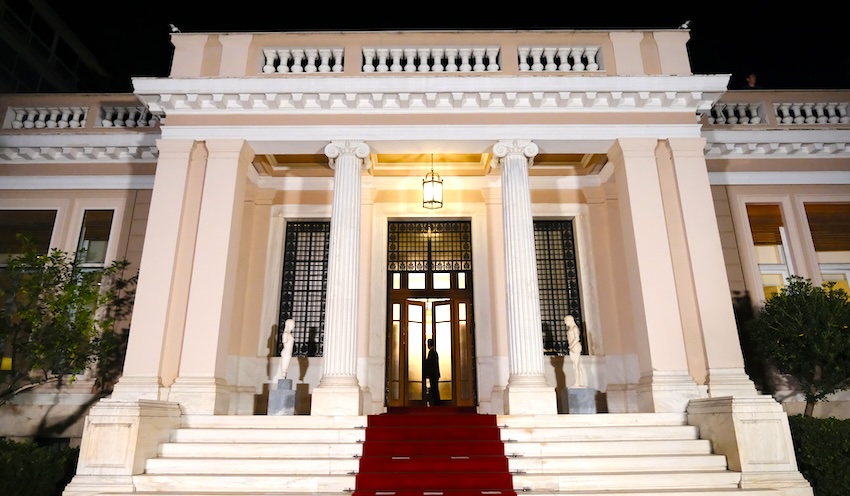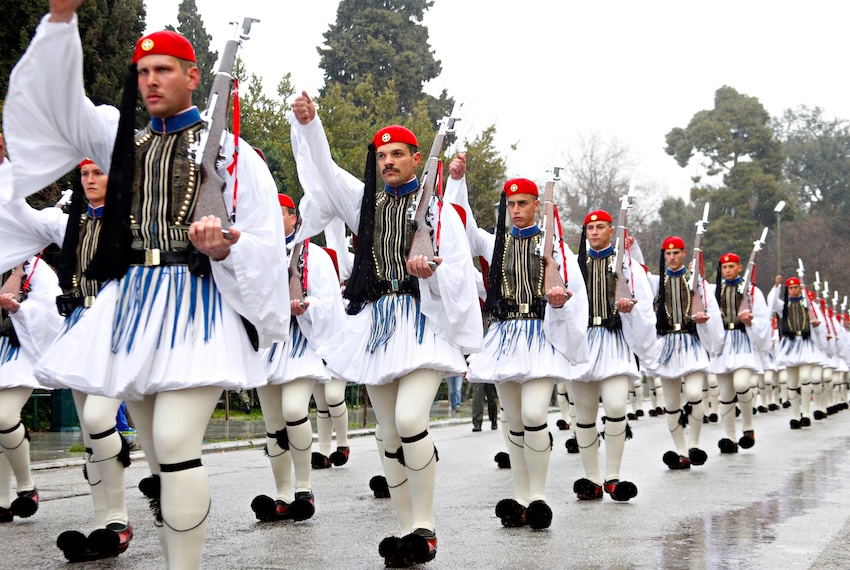
The National Gardens
Zappion, Panathenaic Stadium and Temple of Olympian Zeus
|
|
|
The National Gardens of Athens is the best place to escape the city and with the areas of the Plaka, Acropolis, Thission, Monastiraki and Psiri all connected by pedestrian streets and parks you barely have to go through Athens to get there. |
|
Behind the
Tomb of the Unknown soldier on Amalias street, at the
top of
Syntagma (Constitution) Square
is what my brother
calls "Athens greatest treasure". Formerly The
Kings Garden, now the National Garden, it is
like a tropical paradise right in the middle of the
concrete jungle of Athens. You can spend hours
wandering around the shaded pathways past flowers and
trees and ducks. There are two duck ponds and a duck
population that has gotten completely out of control.
There are the remains of ancient Athens scattered
around and several dozen cats. The National Garden is
a great place to escape the noise and heat of Athens.
Especially if you like
ducks. In what used to be the private garden of the king an event took place that changed the course of history for Greece and made it what it is today, a small country in the eastern Mediterranean, instead of a large country spread over two continents with its capital in Constantinople. This event was a the bite of a monkey. |
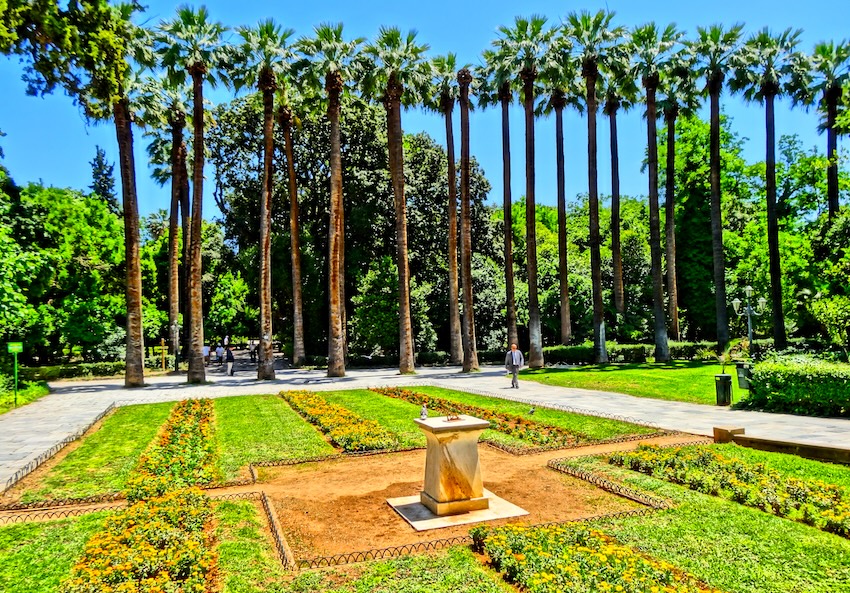 |
|
After the first world war things were looking up for Greece. The Germans had been defeated and Turkey which had been allied with them, was falling apart. Under Eleftherios Venizelos, Greece's greatest statesmen and one of the most intelligent and respected leaders in Europe, the country had tripled in size and it's army controlled Smyrna on the coast of Asia Minor, an international city full of Greeks who had lived there for thousands of years, as well as many other towns on the coast which were also full of Greeks. The Greek army had the support of the European powers and what was left of the Turkish army was disorganized and on the run. It seemed that Greece would achieve it's dream of the megalo idea: the Great Idea, a greater Greece with it's capital in Constantinople (Istanbul): A second Byzantine Empire. Then on Sept 30th 1920, while walking in the gardens, King Alexander was bitten by a monkey. He died three weeks later. His brother Constantine, a Germano-phile who was unpopular with the European powers, returned to Greece and in elections the Royalists triumphed over the Venizelists. To make a long story short, the king removed the Venizelists officers from the army just about when the European powers withdrew their support. The French, sensing a change in the winds, began to supply weapons to the young Turks, led by Mustapha Kemal, also known as Attaturk . The Greek army overextended in an ill-advised plan to take Ankara was soundly routed and retreated back to the coast of the Aegean sea bringing with them every Greek from every village, who feared retribution by the Turkish army in hot pursuit. Smyrna was burned to the ground and thousands of Greeks and Armenians were massacred while the British, French, Russian and US Navy just watched from the harbor, waiting to do business with the new Turkish Government. The burning of Smyrna and the evacuation of a million and a half Greeks and Armenians put an end to three thousand years of Hellenic and Christian civilization in Asia Minor and their flood into Athens and the cities and towns of Greece created a refugee problem beyond the scope of any country, much less a small poor one like Greece. Even today the neighborhoods created to house these refugees like Nea Smynri and Kokinia, still have a character of their own. All because of a monkey bite!
It should be
mentioned that the monkey that bit the king was
someone's pet monkey. There are no wild monkeys in
Greece or in the National Garden and you are in no
danger of being bitten. |
|
|
|
But in the National gardens you can forget about history and wars and the ills of modern society and take in the plants, flowers and trees that have been collected from all over the world. There is even a botanical museum on the grounds. In the old days the gates of the park were locked and the people of Athens could only stroll around Zappion, the gardens being the realm of the king and his family. Now it belongs to the people which is as it should be. There is also a small zoo featuring wolves from Bulgaria, strange antelope like creatures, monkeys, peacocks, hawks, buzzards, a lion, parakeets, canaries and goats, all sharing their cages with the ducks. (Be sure to see the real Athens Zoo too) |
|
|
|
Keep your eyes and ears open for strange bird calls because there is a large population of parrots that live in the National Gardens. No they are not indigenous to Greece. These are birds that escaped, some of which were pets of Greeks living in Africa who returned to Greece bringing the birds with them. If you hear a bird that sounds tropical just look up and you will probably see one. They are also making their way to other parks and green areas in Athens and I have seen one in Plaka and on Fokionos Negri. |
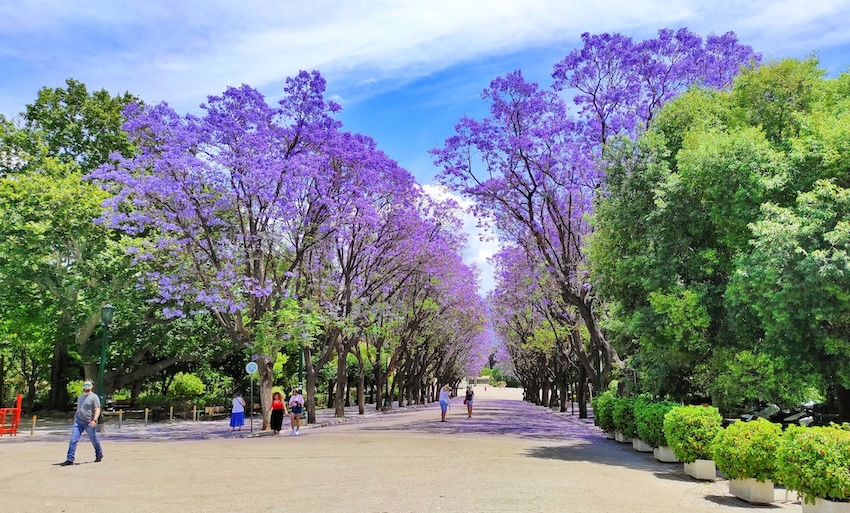 |
|
The Zappion Building If you walk downhill on Irodou Attikou you will pass Zappion on the right where in the summer you can see puppet theater (Karagiosis) and other forms of entertainment at the large outdoor cafe. Some summers they have outdoor movies here. This area is a popular place for Athenians to stroll and sit when the weather is nice. The Zappion is used as an exhibition hall and for official events so take a look inside and see if there is anything going on. There are park benches and a couple cafes in the area between IrodouAttikou and Amalias street.
|
|
Henry
Miller wrote about the National Gardens in
1939:
|
|
|
|
The Evzones and the Former King's Palace If you walk out to Irodou Atikou Street on your left is the camp of the Evzones, who guard the Tomb of the Unknown Soldier and what was once the King's Palace across the street. It's now called Maximos Mansion and is the home of the Prime Minister, (though they say he prefers his apartment). The palace was built by Ernst Ziller who had designed many of the buildings in the new city of Athens in the late 1800s. Instructed to build a small palace for Prince Constantine and his bride Sophia, the princess was so unhappy with the results she fired him because it was too small. Ziller died broke on Solonos Street though he has certainly left his mark on Athens and all over Greece. |
|
|
|
Evzone means well belted and the term goes back to Homer to describe soldiers known for their fighting ability. They were founded in 1824 during the war for Independence and in 1864 became the elite troops of the Greek army. The kilt they wear is called a fustanella and were worn by the klefts , the freedom fighters who fought the Turks in the war for Independence. There are about 200 evzones and they are chosen from among the soldiers for their height and charactor. Among their duties are guarding the Presidential Mansion, the Tomb of the Unknown Soldier (Every Sunday at 11 they ceremoniously change the guard) and raising and lowering the flag of the acropolis. During Easter they have a celebration at the Evzone camp with roast lamb and wine and if you are wandering around lonely and friendless on Easter Sunday maybe they will invite you in. My mother-in-law went to this party and she and an evzone fell in love with each other and she wrote a book about it that she has been trying to get published for years. It is very romantic and would make a great movie! If you walk up the street you will come to Vassilias Sophias street and the Benaki Museum and further up the hill is Kokonaki Square . If you take a right on Vassilias Sophias street you can visit the Byzantine Museum and the War Museum next door to each other. See Museums |
|
|
|
Panathinaiko Olympic Stadium |
|
Across the street from Zappion is the Panathinaiko Olympic Stadium, also known as which means beautiful marble, rebuilt entirely of marble in 1896 for the first modern Olympics by Evangelis Zappas and George Averoff, though the stadium was actually rescued from antiquity and previously restored in 1870, also by Zappas. The stadium was originally built in the 330 BC for the Panathenaic contests. In the Roman period it is said that 1000 wild animals were slaughtered here to celebrate the inauguration of the Emperor Hadrian in 120 AD. The Stadium sits in a hollow of Arditos Hill and you can climb to the top for some really great views of the Acropolis and Mount Lykavettos and a walk from one end to the other should be all the exercise you need for one day. On sunny days there are usually lots of people here, mostly children playing ball, some athletes practicing and many people hanging out at the cafe near the entrance. The stadium can seat 50,000 people. I saw the Harlem Globetrotters here in 1971. There is a jogging track on the hill which surrounds it but if you want some real exercise just run up and down the steps a couple times and you will easily burn off last nights meal. See also my Panathinaiko Olympic Stadium page for more photos and information. When you cross the street from the National gardens and the Zappion you are actually crossing the Illissos River which is underneath the traffic, making its way to the sea as it has for aeons, though now a little dirtier. In the 18th century girls left offerings in a certain spot on the shore, close to the entrance of the stadium, to assure themeslves of getting a good husband. According to Pausanias there was a statue of Venus
nearby. There is a plan to raise the river
and put the traffic underground that will make the
city even more appealing should they actually do it.
But even if they don't this area around the National
Gardens is worth spending time in, especially if you
have children. If you have a soft spot in your heart
for ducks you will be particularly happy here. The area to the right of the stadium on the pine-covered Arditos Hill is called Mets, named for a Bavarian beer hall that was built here in 1870. It was also known as the Pandremenadika or the getting married place after the 60 year courtship of an 80 year old man named Yiannis Marinos to his 75 year old bride in a marriage that took place here. Later it was known for the many bordelos. Now it is home to the Athens Centre Greek Language School, several tavernas and bars including the Half Note Jazz Club which is right across the square from Athens First Cemetery, the resting place of the most well known people in modern Greek history, music, art and culture and an amazing place to wander through with its tree-shaded lanes and magnificent monuments. |
|
|
| Temple of Olympian Zeus |
|
If you walk back, towards the Zappion building you will pass the Temple of Olympian Zeus the largest of the ancient Greek temples, one of the first to be concieved and the last to be completed. Started during the 6th Century BC by Peisistratos it was not finished until 131 AD by the Emperor Hadrian who ruled the city during the Roman period over700 years later. It must be inspected up close to really appreciate just how big it actually was. Originally there were 104 Corinthian columns of which only 15 remain standing. One of the columns actually blew down in a storm in 1852. In the period that followed Greek Independence the area was the site for the original celebration of what we now call Apokreas which many of us know as carnival, as practiced in places like New Orleans and Rio de Janairo and modern day Athens. In the early 1800s a stylite (a group of ascetics who spent long periods sitting or standing on top of pillars or columns. The word comes from the Greek stylos for column.) built his dwelling on top of one of the columns of the temple and it can be seen in early paintings and drawings. Nearby is the Arch of Hadrian which was erected in 132 AD as a gate between the ancient city and the Roman city of Athens. When you leave the temple of Zeus you can cross Amalias and you will be right back in the Plaka. If you walk a couple blocks to your left on Amalias you will come to the pedestrian avenue of Dionysiou Aeropagitou which will take you to Makrianni-Koukaki, the entrance to the Acropolis Museum and the Acropolis and all the way to Thission, Monastiraki and Psiri. |
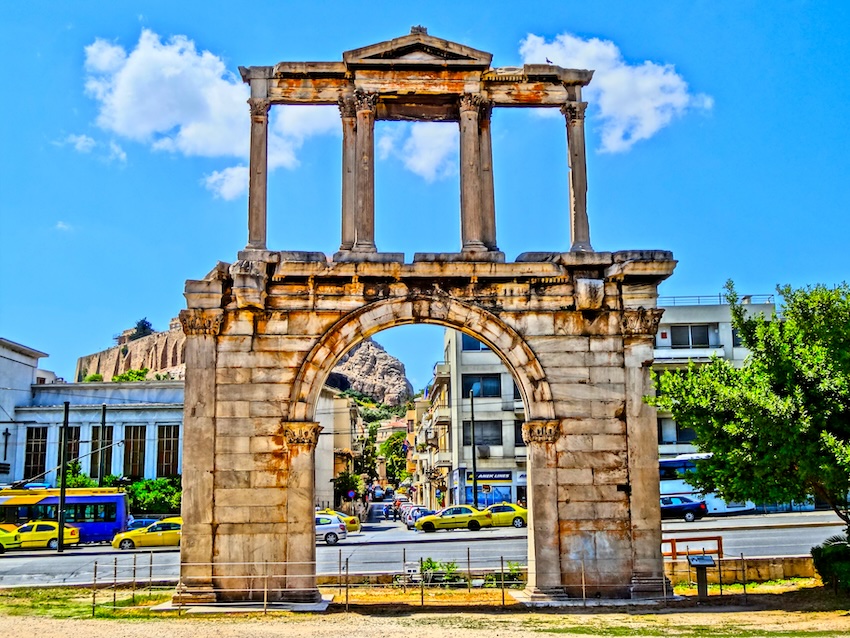 |
|
Tourist Information Fantasy Travel's Athens Walking Tour includes the National Gardens and the other places mentioned on this page. If you want to stay within easy walking distance of here any hotel in Syntagma, Plaka or Makrianni is not only close but you can get here by walking on pedestrian streets and only crossing a couple big streets. See Athens Hotels or get assistance from a Recommended Greek Travel Agency. |
Return to Athens Survival Guide
Help Support Matt's Greece Guides
Do you enjoy using my site? Have you found it entertaining as well as useful? If so please show your appreciation by booking hotels through the travel agencies and the links found on my Hotels of Greece site. The small commission I make on the bookings enable me to keep working and in most cases you won't find them any cheaper by searching elsewhere.
If you are appreciative of all the free information you get on my websites you can also send
a donation through Paypal or Venmo
Join Matt Barrett's Greece Travel Guides Group on Facebook for comments, photos and other fun stuff. If you enjoy this website please share it with your friends on Facebook and other social media.
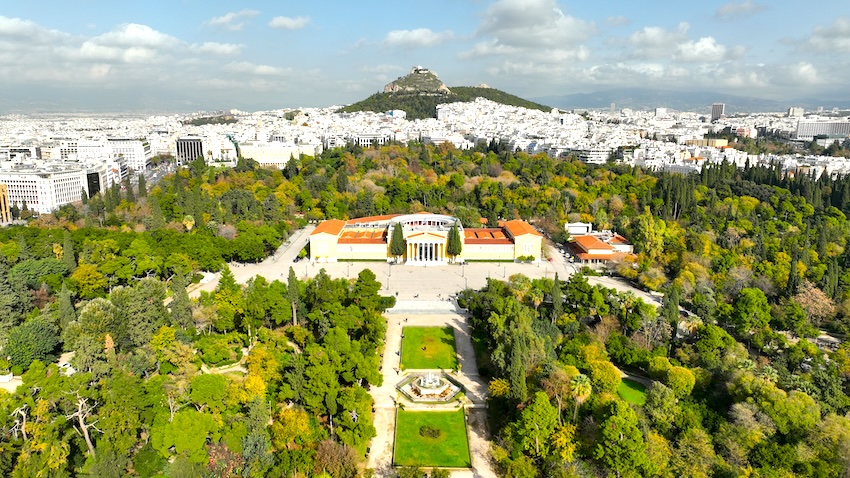

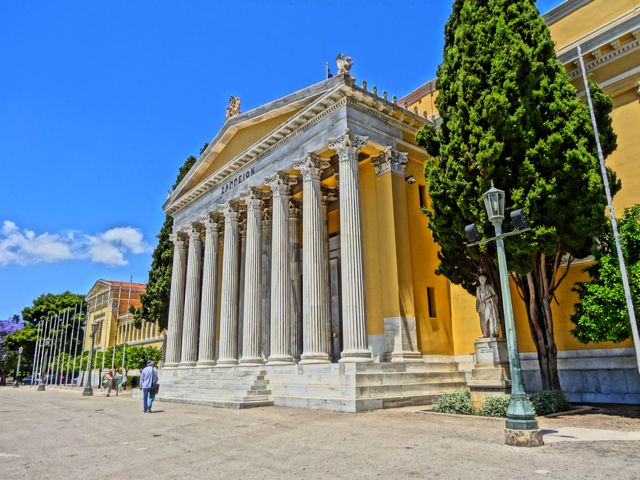 The Zappion was built
in 1878 and donated to the nation by the Zappas
brothers from Ipirus.
This building was the first to hold an indoor Olympic event, in the 1896 Olympics. In fact even though credit as the founder of the modern Olympics goes to Pierre de Coubertin, and his name is mentioned in every Olympic ceremony and in the media, in truth, Coubertin only founded the International Olympic Committee (IOC). The founders of the modern Olympics were three people. In 1833 Panagiotis Soutsos wrote about the revival of the Olympic Games in
his poetry 'Dialogue
of the Dead'. In 1850 Dr William Penny Brookes founded annual games in Much Wenlock, Shropshire, UK. In 1856 Evangelis Zappas wrote to King Otto of Greece offering to fund the revival of the Olympic Games. The first modern international Olympic Games were held in Platia Kotzia, Athens in 1859, sponsored by Zappas. In 1870, when Coubertin was just seven years old, the first modern Olympics to be held in a stadium took place in the ancient Panathenaic stadium (below) of Athens which
had been rebuilt by Zappas. So the Zappion building is an important place to visit and acknowlege the true founder of the Modern Olympics, even if the International Olympic Committee does not want to.
The Zappion was built
in 1878 and donated to the nation by the Zappas
brothers from Ipirus.
This building was the first to hold an indoor Olympic event, in the 1896 Olympics. In fact even though credit as the founder of the modern Olympics goes to Pierre de Coubertin, and his name is mentioned in every Olympic ceremony and in the media, in truth, Coubertin only founded the International Olympic Committee (IOC). The founders of the modern Olympics were three people. In 1833 Panagiotis Soutsos wrote about the revival of the Olympic Games in
his poetry 'Dialogue
of the Dead'. In 1850 Dr William Penny Brookes founded annual games in Much Wenlock, Shropshire, UK. In 1856 Evangelis Zappas wrote to King Otto of Greece offering to fund the revival of the Olympic Games. The first modern international Olympic Games were held in Platia Kotzia, Athens in 1859, sponsored by Zappas. In 1870, when Coubertin was just seven years old, the first modern Olympics to be held in a stadium took place in the ancient Panathenaic stadium (below) of Athens which
had been rebuilt by Zappas. So the Zappion building is an important place to visit and acknowlege the true founder of the Modern Olympics, even if the International Olympic Committee does not want to.